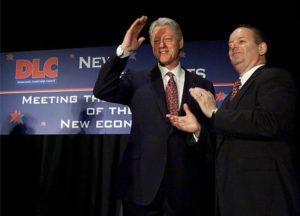Reconsidering Jesse Jackson: The Caricature, The Person, The Politician-Part 4
This post, written by Tim Lacy, was originally published on the Society for U.S. Intellectual History’s blog and is reprinted here with permission.

Today’s post is the fourth and final installment in my four-part argument about the history and significance of the Reverend Jesse Jackson, Sr., as a political activist and thinker. My thesis is this: A full reconsideration of the politics, ideology, and political philosophy of the 1970-2000 period must involve a new, long, and serious study of Jesse Jackson. The first three installments are here, here, and here. The first post began with some personal anecdotes about how Jackson has been caricatured. The second covered Jackson’s early biography and 1970s activism. The third addressed Jackson’s national political career in the 1980s. Today I return to Jason Stahl’s new book and Jackson’s relation to the “right moves” of the Democratic Party in the 1990s.
————————————————————-
IV. The Politician, Part B
Stahl’s account, without addressing the internal machinations or intellectual history of Jackson’s work, displays how Jackson’s fellow Democrats abandoned him, and what he represented, in the Democratic Party. Jackson arises when Stahl considers the role of the Progressive Policy Institute, a center-left think thank created 1999 to feed ideas to the political arm that had led to its creation: the Democratic Leadership Council, founded in 1985 and headed by Alvin (Al) From, and later Bill Clinton. In light of the longer history of conservative think tanks, Stahl frames the PPI and DLC members against what they called “liberal fundamentalists.” According to DLC types, Jackson led those lefty ideologues who had supposedly captured the party apparatus during the 1980s. 1
 This framing of Jackson occurred when, to Stahl, Democratic leadership accommodated itself to the “rising ascendant conservatism and the marketplace of ideas.” The latter was a device used by conservatives during the 1960s to 1980s to frame intellectual life as a perpetual competition, and to compel the liberal establishment to see conservatism as another identity that deserved a hearing for the sake of balance. By accommodating this new “identity,” Stahl argues, Democrats “moved the entire American political spectrum to the right.” 2
This framing of Jackson occurred when, to Stahl, Democratic leadership accommodated itself to the “rising ascendant conservatism and the marketplace of ideas.” The latter was a device used by conservatives during the 1960s to 1980s to frame intellectual life as a perpetual competition, and to compel the liberal establishment to see conservatism as another identity that deserved a hearing for the sake of balance. By accommodating this new “identity,” Stahl argues, Democrats “moved the entire American political spectrum to the right.” 2
Jackson represented the hitherto unchallenged view, since the New Deal, that the Democratic Party was built on coalitions of smaller constituencies. To Stahl, unity emerged from grassroots organizing around a progressive agenda. This was how Jackson ran his campaigns in 1984 and 1988. Al From’s “new” vision would be the exact opposite. The DLC and later the PPI would start with elites in party and in business—primarily Southern white men, no women—to organize “mainstream” or, eventually, “New Democrats.” These new Democratic politicians would define themselves against “special interests” and “single-issue interest groups” that had dominated party politics. This rhetorical move allowed the DLC to show how it could be friendly to business leaders. The Democrats were not hostage to social movements from the 1960s. By 1989 businesses were sponsors rather than merely another interest group. 3
Against this new backdrop Jackson no longer appeared as a unifying, heroic CRM activist, but rather just another essentialist for African Americans. His interests, however he enabled them to coalesce with others, appeared to fracture the party. But Jackson tried to work with the DLC at first. Stahl records that at a 1987 DLC meeting Jackson offered an olive branch, rhetorically accompanied by the proverbially attendant dove: “The party has a progressive wing. It has a conservative wing. But it takes two wings to fly.” The party was a “family” with a diverse set of brothers and sisters: “environmentalists, women, American Indians, peace advocates, farmers, and many others.” 4
The 1989 creation of the PPI, however, hardened the lines of difference. In exploring the PPI’s founding documents, it is clear that Jackson’s vision for the party was the “purest version of liberal fundamentalism.” In light of Dukakis’ 1988 defeat, the Democratic party must be rescued from social movement politics. That iteration of the party had been soft on crime and indifferent to victims, encouraging dependence with over-generous welfare policies, taxing in an out-of-control fashion, and embracing cultural and social values out of the mainstream. 5 Jackson was their chosen bogeyman.
Jackson, however, didn’t yet give up on the DLC. Because the DLC and PPI still recognized the erosion the middle class during the Reagan years, and called for more progressive tax policies, he still engaged New Democrats. He saw the power of their message, and realized he needed their backing. Stahl relays that Jackson addressed the DLC in 1990 with a speech, titled “Delighted to be United.” As reported in the Washington Post, therein he praised the DLC for “embracing his views on progressive taxation, military budget cuts and investments in education and economic development.” Stahl notes an ironic dig by Jackson, in the report, when the latter welcomed the DLC to the “new mainstream.” 6
Bill Clinton and Al From, circa 2000. Credit: Picture found at Hollywood on the Potomac (March 29, 2016 post).
Reaction to the speech by DLC members was predictably negative, and eventually catalytic. Al From labeled it “bizarre.” He called it “foolish for anyone to think that the party moved in Jesse Jackson’s direction.” In that same Washington Postarticle, Bill Clinton separated DLC positions from Jackson’s “class warfare” rhetoric. Clinton also denigrated Jackson’s call for deep cuts in military spending, advocating instead for “measured” reductions. In Stahl’s telling, it was this response that instigated the “New Democrat” position, rolled out in 1991—as an advance over the DLC’s “Mainstream Democrat” identity that had reigned. The New Democrat, then, was someone explicitly opposed to Jackson’s politics. 7
Here Stahl implicitly provides a sensibility for this new DLC creation. A New Democrat sought to forward middle-class values with the streamlined, highly-efficient, technologically savvy modern state. The “newness,” Stahl writes, “advance[d] a feeling of modernity–of being ahead of one’s time in understanding the world as is.” 8 The New Democrats were an elite vanguard that updated the Democratic party, bringing into being a business-friendly entity that could harness the market for American liberal ends—bringing together the European and American versions of liberalism. It was literally a neo-liberalism, though Stahl generally avoids the complications of that term. A newer deal–what From called “the new politics”—with American businesses superseded the old New Deal. And it was defined against Jackson as the “liberal fundamentalist” of grassroots and coalition-focused politics. This new vision literally excluded Jackson from future meetings of the DLC, beginning in 1991.9
That exclusion produced Jackson’s famous quip about the DLC being “the Mason-Dixoncrats.” As Stahl narrates the pivot, Jackson’s hostility undermined his coalition-building persona and “magnif[ied] the importance of the DLC and their new identity.”10 Jackson became a non-factor in national political circles after this point.
 In leaving Jackson behind, New Democrats were free to characterize old liberalism as industrial-oriented, sluggish, bureaucratic, regulatory (notwithstanding Carter’s actions on that front), hierarchical, and inefficient. This new political sensibility traded on being cool, creative, and rebellious. Stahl calls it a “quasi-populist sensibility,” but it feels more to me like a political application of Thomas Frank’s Conquest of Cool—a “hip consumerism” in 1990s politics. 11 Was any president more cool, witty, and jazzy than Bill Clinton, in his day and context? He was something to behold, to be consumed by the political elites. In this way he foreshadowed the cool of the next New Democrat, Barack Obama.
In leaving Jackson behind, New Democrats were free to characterize old liberalism as industrial-oriented, sluggish, bureaucratic, regulatory (notwithstanding Carter’s actions on that front), hierarchical, and inefficient. This new political sensibility traded on being cool, creative, and rebellious. Stahl calls it a “quasi-populist sensibility,” but it feels more to me like a political application of Thomas Frank’s Conquest of Cool—a “hip consumerism” in 1990s politics. 11 Was any president more cool, witty, and jazzy than Bill Clinton, in his day and context? He was something to behold, to be consumed by the political elites. In this way he foreshadowed the cool of the next New Democrat, Barack Obama.
The last appearance of Jackson in Stahl’s text serves as the symbolic nail in the coffin of Jackson’s national political career: the Sister Souljah moment.12 It was the final repudiation, delivered by Clinton, of Jackson’s lefty coalition. Social movement politics were dead to Democrats for the rest of the 1990s, and well into the twenty-first century.
Conclusions and Suggestions
What do we make of all this? I have five thoughts:
First, the drama of Jackson’s 1990-91 repudiation demonstrates that political accounts of the period must go through the thought, actions and community of discourse of Jesse Jackson. I feel the thesis of my four-part series stands. Any narrative that minimizes Jackson’s importance isn’t telling the truth about history.
Second, my cursory explorations did not uncover the intellectual influences of key colleagues from the SCLC, Chicago Theological Seminary, Operation Breadbasket, Operation PUSH, Rainbow Coalition, or Rainbow/PUSH Coalition. Those influences may reveal themselves in biographies and autobiographies that I did not have the time to explore for these posts.
Third, among recent historians, it seems only Stahl and Dan Rodgers have taken Jackson seriously. Rodgers analyzed his rhetoric, but even that analysis seemed to take Jackson’s words at face value, to bundle the rhetoric topically for a meta analysis. Stahl looks hard at Jackson as a unwilling and tragic political symbol within his own party. It was, to me, as if economic issues were coded “black” in the late “go-go” 1980s and then downgraded by Democratic party elites. More can be done, by future historians, on Jackson’s deeper ideological roots and sympathies. Were his sympathies that different from the DLC?
Fourth, a question: How have think tanks been coded and structured “white”? Who were the prominent African Americans, women, Latino/as, and other minority figures in “progressive” think tanks? How were their interests treated, or punted? When were “non-whites” brought in for think tanks topics?
Fifth, on my own biography and perceptions of Jackson: It seems a study of perceptions of Jackson, i.e. the caricature, is in order—if it hasn’t been done already. Perhaps one of our readers can enlighten me/us on this.
What say you? What more needs to be done? What other questions have arisen for you?
Tim Lacy is an educator and historian whose scholarly specialties are intellectual history, cultural history, and the history of education. He recently finished a book titled The Dream of a Democratic Culture: Mortimer J. Adler and the Great Books Idea, published by Palgrave Macmillan in 2013, and is working on a second manuscript about ‘great books cosmopolitanism’ before embarking on a larger project about ignorance and anti-intellectualism. Follow him on Twitter @t_lacy.
- Jason Stahl, Right Moves: The Conservative Think Tank in American Political Culture Since 1945 (University of North Carolina Press, 2016), 135-136, 141. Alvin From received the “Perlstein treatment” in the following: Rick Perlstein, “From & Friends,” The Nation, February 11, 2014. ↩
- Stahl, 4, 125, 135. ↩
- Stahl, 136-137, 139, 140, 143-144. ↩
- Stahl, 141. ↩
- Stahl, 142. ↩
- Stahl, 143. ↩
- Stahl, 143-144. ↩
- Stahl, 144. ↩
- Stahl, 145. ↩
- Stahl, 146. ↩
- Stahl, 146. See Thomas Frank, The Conquest of Cool: Business Culture, Counterculture, and the Rise of Hip Consumerism (Chicago: University of Chicago Press, 1997). ↩
- Stahl, 152. ↩

